

Top Tier Evidence. What works in education – Hattie’s list of the greatest effects and why it matters. I have been a fan of John Hattie’s work ever since I encountered Visible Learning.
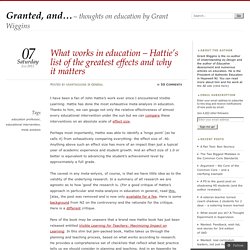
Hattie has done the most exhaustive meta-analysis in education. Thanks to him, we can gauge not only the relative effectiveness of almost every educational intervention under the sun but we can compare these interventions on an absolute scale of effect size. Perhaps most importantly, Hattie was able to identify a ‘hinge point’ (as he calls it) from exhaustively comparing everything: the effect size of .40. Anything above such an effect size has more of an impact than just a typical year of academic experience and student growth. And an effect size of 1.0 or better is equivalent to advancing the student’s achievement level by approximately a full grade. K-12 Education & Learning Innovations with Proven Strategies that Work. Empowering Educators with Evidence on Proven Programs. Common Core Standards: Ten Colossal Errors - Living in Dialogue.
A recent book described the "Reign of Errors" we have lived through in the name of education reform.
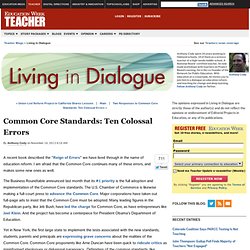
I am afraid that the Common Core continues many of these errors, and makes some new ones as well. The Business Roundtable announced last month that its #1 priority is the full adoption and implementation of the Common Core standards. The U.S. Chamber of Commerce is likewise making a full-court press to advance the Common Core. Major corporations have taken out full-page ads to insist that the Common Core must be adopted. Yet in New York, the first large state to implement the tests associated with the new standards, students, parents and principals are expressing grave concerns about the realities of the Common Core. With this essay, I want to draw together the central concerns I have about the project. The Common Core website has a section devoted to debunking "myths" about the Common Core—but many of these supposed myths are quite true.
The Common Core had a very different origin. 1. BLP TIG Week: Michelle Paul Heelan on Gathering Data To Demonstrate the Impact of Training. My name is Michelle Paul Heelan, Ph.D., an evaluation specialist and organizational behavior consultant with ICF International.
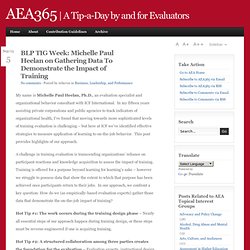
In my fifteen years assisting private corporations and public agencies to track indicators of organizational health, I’ve found that moving towards more sophisticated levels of training evaluation is challenging – but here at ICF we’ve identified effective strategies to measure application of learning to on-the-job behavior. This post provides highlights of our approach.
A challenge in training evaluation is transcending organizations’ reliance on participant reactions and knowledge acquisition to assess the impact of training. Resilience & Youth Development. Resilience Theory At its foundation, a resilience-based approach to youth development is based upon the principle that all people have the ability to overcome adversity and to succeed in spite of their life circumstances.

Resilience is a strengths-based construct, meaning its focus is on providing the developmental supports and opportunities (protective factors) that promote success, rather than on eliminating the factors that promote failure. View a diagram (pdf) of the resiliency based youth development process. A Resilience-Based Youth Development Process Research has consistently shown that the presence of these developmental supports and opportunities (protective factors) provide a better indicator of whether youth will grow up to become successful, well-adjusted adults than does the presence or absence of risk factors (i.e. poverty, drug-use, etc.)
For a useful handout on the RYDM, download our resilience flyer (pdf). Why Resilience Matters to Schools Publications. Learningtheories-full.jpg (1614×1145) Learningtheories-full.jpg (1614×1145) CAREI Reports. Minneapolis Public Schools Observational Drawing Evaluation Report Minneapolis Public Schools (MPS) was awarded a grant by American Honda Foundation to implement observational drawing in 20 elementary classrooms in 2010.
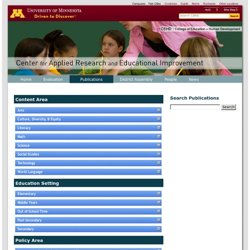
Minneapolis Public Schools used observational drawing to teach skills of observation and apply them in the context of scientific investigation. Classroom teachers and the teaching artists had varying levels of experience with observational drawing. Minneapolis Public Schools contracted with the Center for Applied Research and Educational Improvement (CAREI) to assess the impact of implementing this technique in a sample of MPS classrooms. FACETS: Focus on Arts, Culture and Excellence for Teachers and Students In 2008, a 3-year Professional Development for Arts Educators (PDAE) grant was awarded by the U.S. Neighborhood Bridges: 2010-2011 Evaluation Report Project AIM 2009-2010 Evaluation Report Arts for Academic Achievement Developing Readers Project. Out-of-School Time. Research : Youth Development. Education Minnesota Guskey's 5 levels of evaluation.
Determining the best fit of a professional development event for your local context requires recognition, “collection and analysis of the five critical levels of information” (Guskey 2002).
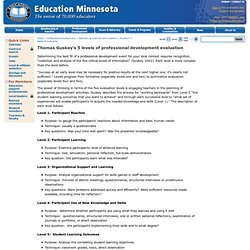
Each level is more complex than the level before. “Success at an early level may be necessary for positive results at the next higher one; it’s clearly not sufficient.” Levels progress from formative (especially levels one and two) to summative evaluation (especially levels four and five). The power of thinking in terms of the five evaluation levels is engaging teachers in the planning of professional development activities.
Guskey describes the process for "working backwards" from Level 5 "the student learning outcomes that you want to achieve" and through each successive level to "what set of experiences will enable participants to acquire the needed knowledge and skills (Level 1). " Level 1: Participant Reaction Level 2: Participant Learning Level 3: Organizational Support and Learning.
Service-Learning. Achievement Gap. Teen Driver Safety.